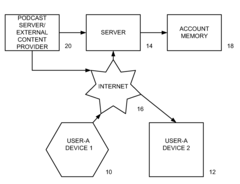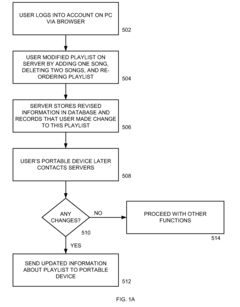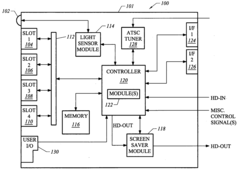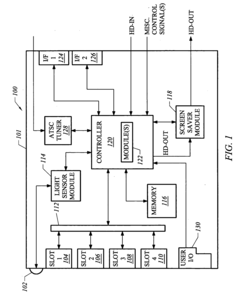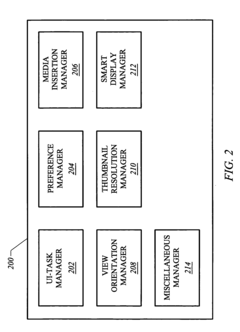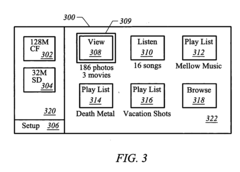Investigating Dolby Vision’s Expansion in Portable Media Devices
JUL 30, 20259 MIN READ
Generate Your Research Report Instantly with AI Agent
Patsnap Eureka helps you evaluate technical feasibility & market potential.
Dolby Vision Evolution
Dolby Vision has undergone significant evolution since its introduction in 2014, marking a transformative journey in the realm of high dynamic range (HDR) imaging technology. Initially developed for cinema and high-end televisions, Dolby Vision has progressively expanded its reach to encompass a wider array of devices and platforms, including portable media devices.
The technology's evolution can be traced through several key milestones. In its early stages, Dolby Vision was primarily focused on enhancing the viewing experience in professional cinema environments and premium home entertainment systems. This phase saw the implementation of advanced color grading tools and the establishment of a robust ecosystem for content creation and distribution.
As consumer demand for superior visual experiences grew, Dolby Vision began to adapt to more diverse display technologies. The introduction of Dolby Vision IQ in 2020 marked a significant advancement, incorporating ambient light sensors to dynamically adjust HDR performance based on viewing conditions. This innovation greatly improved the technology's versatility across various lighting environments, making it more suitable for portable devices.
The expansion into mobile devices represented a crucial turning point in Dolby Vision's evolution. This shift required substantial optimization to address the unique challenges posed by smaller screens, variable lighting conditions, and power constraints inherent to portable devices. Dolby engineers focused on developing more efficient algorithms for real-time HDR processing and metadata interpretation, ensuring that the technology could deliver its signature visual quality without compromising device performance or battery life.
Another significant development in Dolby Vision's evolution was the introduction of Dolby Vision Profile 8.4, specifically designed for mobile applications. This profile enabled the delivery of Dolby Vision content to a wider range of devices, including smartphones and tablets, by optimizing the format for lower-bandwidth scenarios and varying display capabilities.
The technology's progression also saw the integration of Dolby Vision with other cutting-edge display technologies, such as OLED and mini-LED, further enhancing its capabilities on portable screens. This synergy allowed for even greater contrast ratios, deeper blacks, and more vibrant colors on compact displays, pushing the boundaries of what was previously achievable on mobile devices.
As Dolby Vision continued to evolve, it expanded beyond just video playback to encompass content creation tools for mobile platforms. This development empowered users to capture, edit, and share Dolby Vision content directly from their portable devices, democratizing high-quality HDR content creation and fostering a new ecosystem of mobile-first HDR experiences.
The technology's evolution can be traced through several key milestones. In its early stages, Dolby Vision was primarily focused on enhancing the viewing experience in professional cinema environments and premium home entertainment systems. This phase saw the implementation of advanced color grading tools and the establishment of a robust ecosystem for content creation and distribution.
As consumer demand for superior visual experiences grew, Dolby Vision began to adapt to more diverse display technologies. The introduction of Dolby Vision IQ in 2020 marked a significant advancement, incorporating ambient light sensors to dynamically adjust HDR performance based on viewing conditions. This innovation greatly improved the technology's versatility across various lighting environments, making it more suitable for portable devices.
The expansion into mobile devices represented a crucial turning point in Dolby Vision's evolution. This shift required substantial optimization to address the unique challenges posed by smaller screens, variable lighting conditions, and power constraints inherent to portable devices. Dolby engineers focused on developing more efficient algorithms for real-time HDR processing and metadata interpretation, ensuring that the technology could deliver its signature visual quality without compromising device performance or battery life.
Another significant development in Dolby Vision's evolution was the introduction of Dolby Vision Profile 8.4, specifically designed for mobile applications. This profile enabled the delivery of Dolby Vision content to a wider range of devices, including smartphones and tablets, by optimizing the format for lower-bandwidth scenarios and varying display capabilities.
The technology's progression also saw the integration of Dolby Vision with other cutting-edge display technologies, such as OLED and mini-LED, further enhancing its capabilities on portable screens. This synergy allowed for even greater contrast ratios, deeper blacks, and more vibrant colors on compact displays, pushing the boundaries of what was previously achievable on mobile devices.
As Dolby Vision continued to evolve, it expanded beyond just video playback to encompass content creation tools for mobile platforms. This development empowered users to capture, edit, and share Dolby Vision content directly from their portable devices, democratizing high-quality HDR content creation and fostering a new ecosystem of mobile-first HDR experiences.
Portable Device Market
The portable device market has experienced significant growth and transformation in recent years, driven by technological advancements and changing consumer preferences. This market encompasses a wide range of devices, including smartphones, tablets, laptops, and wearables, all of which have become integral parts of modern life.
Smartphones continue to dominate the portable device market, with global shipments reaching over 1.3 billion units annually. The market is characterized by intense competition among major players such as Apple, Samsung, Xiaomi, and Huawei. These companies constantly innovate to differentiate their products, focusing on features like improved cameras, 5G connectivity, and enhanced display technologies.
Tablets have seen a resurgence in popularity, particularly during the COVID-19 pandemic, as remote work and education became more prevalent. The global tablet market has shown steady growth, with annual shipments exceeding 160 million units. Apple's iPad remains the market leader, followed by Samsung and other Android-based manufacturers.
The laptop market has also evolved, with ultrabooks and 2-in-1 devices gaining traction. These portable computers offer a balance between performance and mobility, catering to both professional and consumer needs. The global laptop market size is estimated to be over 200 million units per year, with major players including Lenovo, HP, and Dell.
Wearable devices, such as smartwatches and fitness trackers, represent a rapidly growing segment of the portable device market. The global wearable technology market is projected to reach a value of over $100 billion by 2026, driven by increasing health consciousness and the integration of advanced features like ECG monitoring and sleep tracking.
The portable device market is heavily influenced by technological trends such as 5G adoption, artificial intelligence integration, and improved display technologies. Dolby Vision, as a premium HDR (High Dynamic Range) technology, has the potential to significantly impact the market, especially in high-end smartphones and tablets where display quality is a key differentiator.
Consumer demand for enhanced multimedia experiences on portable devices continues to grow, creating opportunities for technologies like Dolby Vision. As streaming services expand their HDR content offerings, there is an increasing need for devices capable of displaying this content in its full visual glory. This trend aligns well with Dolby Vision's expansion strategy in the portable device market.
Smartphones continue to dominate the portable device market, with global shipments reaching over 1.3 billion units annually. The market is characterized by intense competition among major players such as Apple, Samsung, Xiaomi, and Huawei. These companies constantly innovate to differentiate their products, focusing on features like improved cameras, 5G connectivity, and enhanced display technologies.
Tablets have seen a resurgence in popularity, particularly during the COVID-19 pandemic, as remote work and education became more prevalent. The global tablet market has shown steady growth, with annual shipments exceeding 160 million units. Apple's iPad remains the market leader, followed by Samsung and other Android-based manufacturers.
The laptop market has also evolved, with ultrabooks and 2-in-1 devices gaining traction. These portable computers offer a balance between performance and mobility, catering to both professional and consumer needs. The global laptop market size is estimated to be over 200 million units per year, with major players including Lenovo, HP, and Dell.
Wearable devices, such as smartwatches and fitness trackers, represent a rapidly growing segment of the portable device market. The global wearable technology market is projected to reach a value of over $100 billion by 2026, driven by increasing health consciousness and the integration of advanced features like ECG monitoring and sleep tracking.
The portable device market is heavily influenced by technological trends such as 5G adoption, artificial intelligence integration, and improved display technologies. Dolby Vision, as a premium HDR (High Dynamic Range) technology, has the potential to significantly impact the market, especially in high-end smartphones and tablets where display quality is a key differentiator.
Consumer demand for enhanced multimedia experiences on portable devices continues to grow, creating opportunities for technologies like Dolby Vision. As streaming services expand their HDR content offerings, there is an increasing need for devices capable of displaying this content in its full visual glory. This trend aligns well with Dolby Vision's expansion strategy in the portable device market.
Technical Challenges
The expansion of Dolby Vision into portable media devices presents several technical challenges that need to be addressed. One of the primary obstacles is the limited processing power and battery life of these devices. Implementing Dolby Vision's advanced HDR technology requires significant computational resources, which can strain the capabilities of mobile processors and drain battery life quickly. This necessitates the development of more efficient algorithms and hardware optimizations to ensure smooth playback without compromising device performance.
Another challenge lies in the display technology of portable devices. Many smartphones and tablets use LCD screens, which struggle to achieve the high contrast ratios and deep blacks required for optimal HDR viewing. OLED displays offer better performance but are more expensive and less common in mid-range devices. Manufacturers must find ways to enhance existing display technologies or develop new ones that can effectively reproduce Dolby Vision's wide color gamut and dynamic range on smaller screens.
Color management and calibration pose additional difficulties in the portable device ecosystem. Unlike TVs or monitors, which can be calibrated in controlled environments, mobile devices are used in various lighting conditions. Ensuring consistent and accurate color reproduction across different ambient lighting scenarios is crucial for maintaining the integrity of Dolby Vision content. This requires sophisticated adaptive display technologies and potentially the integration of ambient light sensors to adjust content dynamically.
The variability in hardware specifications across different portable devices also presents a significant challenge. Unlike standardized TV formats, mobile devices come in a wide range of screen sizes, resolutions, and capabilities. Adapting Dolby Vision content to this diverse ecosystem while maintaining quality and consistency is a complex task that requires flexible encoding and decoding solutions.
Storage and bandwidth limitations are additional hurdles for Dolby Vision on portable devices. The high bitrates required for HDR content can quickly consume limited storage space on mobile devices and strain cellular data networks. Developing more efficient compression techniques that preserve Dolby Vision's quality while reducing file sizes and bandwidth requirements is essential for widespread adoption.
Lastly, the integration of Dolby Vision with existing mobile operating systems and applications presents both technical and logistical challenges. Ensuring compatibility with popular streaming services, video players, and content creation apps requires collaboration between Dolby, device manufacturers, and software developers. This ecosystem-wide approach is necessary to create a seamless user experience and encourage content creators to produce Dolby Vision-compatible material for mobile platforms.
Another challenge lies in the display technology of portable devices. Many smartphones and tablets use LCD screens, which struggle to achieve the high contrast ratios and deep blacks required for optimal HDR viewing. OLED displays offer better performance but are more expensive and less common in mid-range devices. Manufacturers must find ways to enhance existing display technologies or develop new ones that can effectively reproduce Dolby Vision's wide color gamut and dynamic range on smaller screens.
Color management and calibration pose additional difficulties in the portable device ecosystem. Unlike TVs or monitors, which can be calibrated in controlled environments, mobile devices are used in various lighting conditions. Ensuring consistent and accurate color reproduction across different ambient lighting scenarios is crucial for maintaining the integrity of Dolby Vision content. This requires sophisticated adaptive display technologies and potentially the integration of ambient light sensors to adjust content dynamically.
The variability in hardware specifications across different portable devices also presents a significant challenge. Unlike standardized TV formats, mobile devices come in a wide range of screen sizes, resolutions, and capabilities. Adapting Dolby Vision content to this diverse ecosystem while maintaining quality and consistency is a complex task that requires flexible encoding and decoding solutions.
Storage and bandwidth limitations are additional hurdles for Dolby Vision on portable devices. The high bitrates required for HDR content can quickly consume limited storage space on mobile devices and strain cellular data networks. Developing more efficient compression techniques that preserve Dolby Vision's quality while reducing file sizes and bandwidth requirements is essential for widespread adoption.
Lastly, the integration of Dolby Vision with existing mobile operating systems and applications presents both technical and logistical challenges. Ensuring compatibility with popular streaming services, video players, and content creation apps requires collaboration between Dolby, device manufacturers, and software developers. This ecosystem-wide approach is necessary to create a seamless user experience and encourage content creators to produce Dolby Vision-compatible material for mobile platforms.
Current Implementation
01 Display technology for enhanced image quality
Dolby Vision is an advanced display technology that enhances image quality by improving color depth, brightness, and contrast. It utilizes high dynamic range (HDR) techniques to provide a more immersive viewing experience with richer colors and greater detail in both bright and dark areas of the image.- Display technology for enhanced image quality: Dolby Vision is an advanced display technology that enhances image quality by improving color depth, brightness, and contrast. It utilizes high dynamic range (HDR) techniques to provide a more immersive viewing experience with greater detail in both bright and dark areas of the image.
- Audio-visual synchronization and processing: The technology incorporates sophisticated audio-visual synchronization and processing techniques to ensure seamless integration of high-quality video and audio. This includes methods for encoding, decoding, and transmitting audio-visual data to maintain the integrity of the Dolby Vision experience across various devices and platforms.
- Content creation and mastering tools: Dolby Vision includes a suite of content creation and mastering tools that allow filmmakers and content producers to optimize their work for the technology. These tools enable precise control over color grading, brightness levels, and other visual parameters to ensure the creator's intent is preserved across different display devices.
- Adaptive optimization for various displays: The technology incorporates adaptive optimization algorithms that adjust content dynamically based on the capabilities of the display device. This ensures that viewers experience the best possible image quality regardless of whether they are using a high-end television or a mobile device with more limited display capabilities.
- Integration with other audio-visual technologies: Dolby Vision is designed to integrate seamlessly with other audio-visual technologies, including surround sound systems and various video codecs. This integration allows for a comprehensive, high-quality entertainment experience that leverages multiple technological advancements in both video and audio processing.
02 Audio-visual synchronization and processing
The technology incorporates sophisticated audio-visual synchronization and processing techniques to ensure seamless integration of high-quality video and audio. This includes methods for aligning audio and video streams, as well as optimizing sound quality to complement the enhanced visual experience.Expand Specific Solutions03 Content creation and mastering tools
Dolby Vision includes a suite of content creation and mastering tools that allow filmmakers and content producers to optimize their material for the technology. These tools enable precise control over color grading, brightness levels, and other visual parameters to ensure the best possible presentation across compatible devices.Expand Specific Solutions04 Device compatibility and implementation
The technology is designed to be compatible with a wide range of devices, including televisions, monitors, and mobile devices. It involves specific hardware and software implementations to ensure that Dolby Vision-enabled content can be properly displayed on compatible devices, often requiring dedicated chips or processing units.Expand Specific Solutions05 Content delivery and streaming optimization
Dolby Vision incorporates methods for optimizing content delivery and streaming, ensuring that high-quality video can be efficiently transmitted over various networks. This includes adaptive bitrate streaming techniques and compression algorithms specifically designed to maintain image quality while managing bandwidth requirements.Expand Specific Solutions
Key Industry Players
The expansion of Dolby Vision in portable media devices is occurring in a rapidly evolving market characterized by intense competition and technological innovation. The industry is in a growth phase, with increasing demand for high-quality visual experiences on mobile devices. Market size is expanding as consumers seek premium content and immersive viewing experiences on smartphones, tablets, and laptops. Technologically, Dolby Vision is maturing, with major players like Apple, Samsung, and LG Electronics incorporating the technology into their devices. However, the competitive landscape remains dynamic, with companies like Sony, Magic Leap, and Roku also vying for market share in the enhanced visual experience sector. As the technology continues to evolve, we can expect further advancements and wider adoption across various portable media platforms.
Apple, Inc.
Technical Solution: Apple has been a key player in adopting and expanding Dolby Vision for portable media devices. Their implementation focuses on integrating Dolby Vision across their ecosystem of products, including iPhones, iPads, and MacBooks. Apple's approach involves hardware-software integration, utilizing custom-designed chips like the A-series and M-series processors to efficiently handle Dolby Vision processing[4]. They've also developed advanced display technologies, such as the Super Retina XDR OLED displays, which are capable of showcasing the full potential of Dolby Vision content[5]. Apple has further expanded Dolby Vision support to content creation, allowing users to capture, edit, and share Dolby Vision videos directly from their devices, democratizing HDR content creation[6].
Strengths: Seamless ecosystem integration, hardware-optimized performance, content creation capabilities. Weaknesses: Limited to Apple devices, potentially higher cost for consumers.
Dolby Laboratories Licensing Corp.
Technical Solution: Dolby Laboratories has been at the forefront of Dolby Vision technology for portable media devices. Their approach involves implementing advanced HDR (High Dynamic Range) imaging techniques that significantly enhance the visual experience on smaller screens. Dolby Vision uses dynamic metadata to optimize each frame of content, ensuring that the full range of colors and contrasts are preserved even on portable devices with varying display capabilities[1]. The technology adapts to the specific hardware of each device, adjusting brightness, color, and contrast in real-time to deliver the best possible image quality[2]. Dolby has also developed efficient compression algorithms that allow for high-quality Dolby Vision content to be streamed or stored on portable devices without excessive data usage or storage requirements[3].
Strengths: Industry-leading HDR technology, adaptive optimization for various devices, efficient compression. Weaknesses: Requires licensing, may be resource-intensive for some lower-end devices.
Core Dolby Vision Tech
Audio visual player apparatus and system and method of content distribution using the same
PatentInactiveUS20080182510A1
Innovation
- A portable wireless audio and video player with peer-to-peer transfer capabilities, secure subscription-based content management, and user-friendly interface, allowing standalone operation for content search, management, and sharing, using a broadband network for wireless distribution and decryption of content with conditional access controls.
Apparatus and method for presentation of portably-stored content on an high-definition display
PatentInactiveUS20050062888A1
Innovation
- A high-definition media player capable of communicating high-definition video signals to HDTVs, featuring a controller for selecting and generating high-definition images, a screen saver module to prevent burnout, and a media insertion manager for automatic presentation of images from portable storage devices, along with features like auto-bypass and no-motion detect modes to minimize screen fading.
Content Ecosystem
The content ecosystem surrounding Dolby Vision's expansion in portable media devices is a critical factor in its adoption and success. As more manufacturers integrate Dolby Vision technology into smartphones, tablets, and laptops, the availability of compatible content becomes increasingly important.
Major streaming platforms have been at the forefront of embracing Dolby Vision. Netflix, Amazon Prime Video, and Apple TV+ have been consistently expanding their libraries of Dolby Vision-enabled content. This includes both original productions and remastered versions of existing titles. The growing catalog of high-quality, visually stunning content serves as a significant driver for consumer adoption of Dolby Vision-capable devices.
Content creators and production studios are also recognizing the value of Dolby Vision in enhancing the visual experience. Many blockbuster movies and high-profile TV series are now being produced or post-processed with Dolby Vision in mind. This trend is likely to continue as the technology becomes more prevalent in consumer devices.
The gaming industry is another sector that is beginning to explore the potential of Dolby Vision. Some game developers are starting to incorporate Dolby Vision HDR into their titles, particularly for console and PC platforms. As mobile gaming continues to advance, there is potential for Dolby Vision to make inroads into this space as well, further enriching the content ecosystem for portable devices.
User-generated content is an emerging area of interest for Dolby Vision. As more smartphones and tablets incorporate Dolby Vision-capable cameras and displays, there is potential for a surge in HDR content creation at the consumer level. This could lead to increased demand for Dolby Vision support across social media platforms and content sharing sites.
However, challenges remain in ensuring widespread content availability. The process of creating or converting content to Dolby Vision standards can be resource-intensive, which may limit adoption among smaller content producers. Additionally, the fragmentation of HDR standards in the market could pose obstacles to universal content compatibility across different devices and platforms.
Despite these challenges, the content ecosystem for Dolby Vision in portable media devices is showing promising growth. As the technology becomes more prevalent in consumer devices, it is likely to create a positive feedback loop, encouraging more content creators to adopt the standard and further driving consumer demand for Dolby Vision-enabled portable devices.
Major streaming platforms have been at the forefront of embracing Dolby Vision. Netflix, Amazon Prime Video, and Apple TV+ have been consistently expanding their libraries of Dolby Vision-enabled content. This includes both original productions and remastered versions of existing titles. The growing catalog of high-quality, visually stunning content serves as a significant driver for consumer adoption of Dolby Vision-capable devices.
Content creators and production studios are also recognizing the value of Dolby Vision in enhancing the visual experience. Many blockbuster movies and high-profile TV series are now being produced or post-processed with Dolby Vision in mind. This trend is likely to continue as the technology becomes more prevalent in consumer devices.
The gaming industry is another sector that is beginning to explore the potential of Dolby Vision. Some game developers are starting to incorporate Dolby Vision HDR into their titles, particularly for console and PC platforms. As mobile gaming continues to advance, there is potential for Dolby Vision to make inroads into this space as well, further enriching the content ecosystem for portable devices.
User-generated content is an emerging area of interest for Dolby Vision. As more smartphones and tablets incorporate Dolby Vision-capable cameras and displays, there is potential for a surge in HDR content creation at the consumer level. This could lead to increased demand for Dolby Vision support across social media platforms and content sharing sites.
However, challenges remain in ensuring widespread content availability. The process of creating or converting content to Dolby Vision standards can be resource-intensive, which may limit adoption among smaller content producers. Additionally, the fragmentation of HDR standards in the market could pose obstacles to universal content compatibility across different devices and platforms.
Despite these challenges, the content ecosystem for Dolby Vision in portable media devices is showing promising growth. As the technology becomes more prevalent in consumer devices, it is likely to create a positive feedback loop, encouraging more content creators to adopt the standard and further driving consumer demand for Dolby Vision-enabled portable devices.
Power Efficiency
Power efficiency is a critical factor in the expansion of Dolby Vision technology to portable media devices. As these devices rely on battery power, optimizing energy consumption while maintaining high-quality visual experiences is paramount.
Dolby Vision's implementation in portable devices necessitates sophisticated power management techniques. The technology's dynamic metadata processing and enhanced color mapping require additional computational resources, which can lead to increased power consumption. To address this challenge, manufacturers are exploring various hardware and software optimizations.
One approach involves the use of dedicated image processing chips or co-processors specifically designed to handle Dolby Vision algorithms efficiently. These specialized components can perform the necessary calculations with lower power draw compared to general-purpose processors. Additionally, advancements in semiconductor technology, such as the adoption of more energy-efficient process nodes, contribute to reduced power consumption in these dedicated chips.
Software-level optimizations also play a crucial role in improving power efficiency. Intelligent algorithms that selectively apply Dolby Vision processing based on content type and viewing conditions can help conserve energy. For instance, the system may reduce processing intensity for static images or lower-complexity scenes, while fully engaging for high-dynamic-range content that benefits most from Dolby Vision's capabilities.
Display technology advancements further contribute to power efficiency in Dolby Vision-enabled portable devices. OLED displays, which are becoming increasingly common in high-end smartphones and tablets, offer pixel-level control and can selectively illuminate only the necessary areas of the screen. This characteristic aligns well with Dolby Vision's precise control over brightness and contrast, potentially leading to power savings compared to traditional LCD displays.
Battery management systems in portable devices are also evolving to support Dolby Vision more efficiently. Adaptive power schemes can allocate more resources to video processing when needed, while conserving energy during less demanding tasks. Some devices implement machine learning algorithms to predict user behavior and optimize power distribution accordingly, ensuring that Dolby Vision capabilities are available when most likely to be used without unnecessarily draining the battery.
As Dolby Vision continues to expand its presence in portable media devices, ongoing research focuses on further improving power efficiency. This includes exploring new compression techniques that reduce the data processing requirements while maintaining image quality, as well as investigating the potential of low-power AI accelerators to handle some of the complex calculations involved in Dolby Vision rendering.
Dolby Vision's implementation in portable devices necessitates sophisticated power management techniques. The technology's dynamic metadata processing and enhanced color mapping require additional computational resources, which can lead to increased power consumption. To address this challenge, manufacturers are exploring various hardware and software optimizations.
One approach involves the use of dedicated image processing chips or co-processors specifically designed to handle Dolby Vision algorithms efficiently. These specialized components can perform the necessary calculations with lower power draw compared to general-purpose processors. Additionally, advancements in semiconductor technology, such as the adoption of more energy-efficient process nodes, contribute to reduced power consumption in these dedicated chips.
Software-level optimizations also play a crucial role in improving power efficiency. Intelligent algorithms that selectively apply Dolby Vision processing based on content type and viewing conditions can help conserve energy. For instance, the system may reduce processing intensity for static images or lower-complexity scenes, while fully engaging for high-dynamic-range content that benefits most from Dolby Vision's capabilities.
Display technology advancements further contribute to power efficiency in Dolby Vision-enabled portable devices. OLED displays, which are becoming increasingly common in high-end smartphones and tablets, offer pixel-level control and can selectively illuminate only the necessary areas of the screen. This characteristic aligns well with Dolby Vision's precise control over brightness and contrast, potentially leading to power savings compared to traditional LCD displays.
Battery management systems in portable devices are also evolving to support Dolby Vision more efficiently. Adaptive power schemes can allocate more resources to video processing when needed, while conserving energy during less demanding tasks. Some devices implement machine learning algorithms to predict user behavior and optimize power distribution accordingly, ensuring that Dolby Vision capabilities are available when most likely to be used without unnecessarily draining the battery.
As Dolby Vision continues to expand its presence in portable media devices, ongoing research focuses on further improving power efficiency. This includes exploring new compression techniques that reduce the data processing requirements while maintaining image quality, as well as investigating the potential of low-power AI accelerators to handle some of the complex calculations involved in Dolby Vision rendering.
Unlock deeper insights with Patsnap Eureka Quick Research — get a full tech report to explore trends and direct your research. Try now!
Generate Your Research Report Instantly with AI Agent
Supercharge your innovation with Patsnap Eureka AI Agent Platform!
